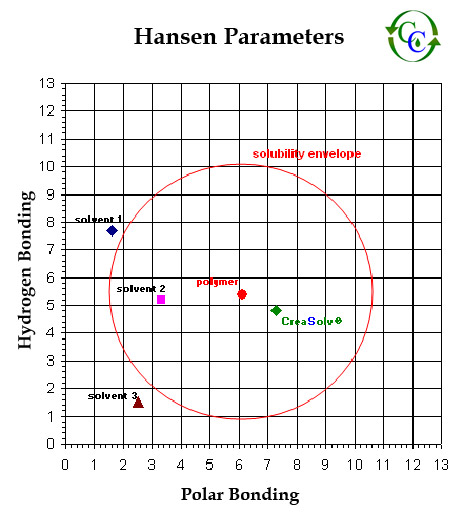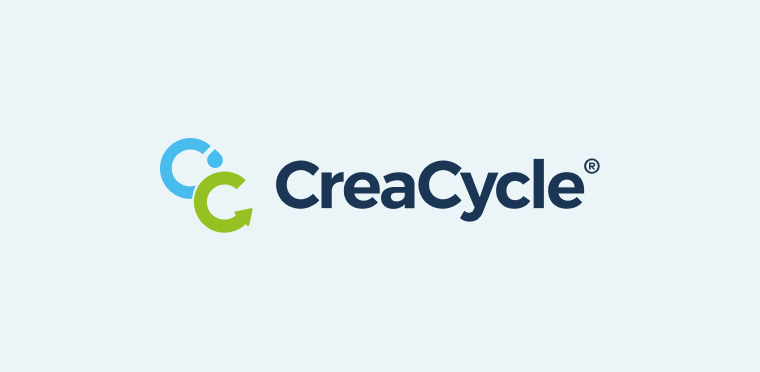In 2002 the CreaCycle GmbH was founded as Start-up and offers special CreaSolv® Formulations for dissolving and recycling of plastics, designed for the CreaSolv® Process
This technique is based on a “selective extraction” and was developed in cooperation with the Fraunhofer Institute for Process Engineering and Packaging (IVV) in Freising, Germany1).
An extraction is a physical separation and purification process practiced for centuries and the employment for plastic recycling is based on the knowledge that different solvents like tetrahydrofurane (THF), xylene, methylethylketone (MEK), dichloromethane (DCM), cyclohexane, cyclohexanone, acetone and terpens can dissolve certain polymers2).
The Vinyloop®-Process is probably the best-known example for dissolving PVC in MEK for recycling purposes. It was in operation since 2002 with an annual capacity of 10.000 tonnes3). The Life Cycle Analysis (LCA)11) from 2013 proves that recycling reduces the global warming potential by 40% and primary energy demand by 47% in comparison to new production12,13) and a Critical Review by DEKRA confirms conformity with ISO standards. In June 2018 production was closed down because the PVC plasticizer di-ethyl hexal phthalate (DEHP) was banned and could not be separated in this plant14).
Because the typical solvents for the selective extraction carry a high hazard potential, CreaCycle specialized in the application of solvents with the lowest risk potential possible for the users and the environment, in order to enable a safe circular economy.
For an investor this means cost savings in the plant equipment. Another important aspect is the commercial availability of CreaSolv® ingredients, because the focus lays on the commercial implementation and not on the scientific proof.
CreaSolv® Formulations consist preferably of solvents, which
- are regarded as safe (ideally not classified according to GHS criteria4))
- are considered as not hazardous to aquatic organisms and biodegradable
- are not regarded as VOC or solvents
Hansen-Solubility-Parameters" are utilized for the calculation of solubility envelopes for selected polymers or plastics5). This allows tailoring of CreaSolv® solvent formulations for specific plastics, because by combining different solvents, it is possible to influence the dissolving ability for certain polymers.
Another critical element is "Greenwashing" with “environmentally friendly” or “green” solvents, because this creates attention and is a good selling argument. However it is kept secret, that these terms are not officially defined.
Creacycle has therefore developed a Comparison Model for Risk Potentials, that is based on known concepts for workplace and environmental safety and which are documented in official “Technical Guidelines”. A “simple” direct comparison of occupational exposure limits can be very dangerous, because a high value is not equivalent to a lower hazard, because it is very important to be aware what hazard one is exposed to. A reversible skin irritation is not to be compared with an explosion risk or a carcinogenic potential.
On 11 October 2000 the German Federal Ministry for Work and Social Affairs presented Dr. Gerald G. Altnau, associate of CreaCycle GmbH, with a certificate for his Vapor-Hazard-Ratio Concept, aimed at replacing dangerous solvent formulations by safer ones. This concept that predominantly focused on the exposure at that time, has been improved in the meantime and can now incorporate different hazards (health/physical-chemical/environment).
A Risk is the chance to be harmed if exposed to a hazard6).
The exposure risk is defined by the Vapor Hazard Ratio VHR and it describes by how many times a vapor saturated air volume hast o be diluted by the same volume so that the occupational exposure limit is not exceeded. The quantity of the VHR allows to assess the necessary safety precautions. Source:
- German Technical Rule TRGS 420, September 1999 7)
- Information of the Employer’s Liability Insurance Association – BGI 536 from February 1997 8)

This concept can also be found in the technical rules of other countries, e.g. Austria (Risikozahl), Denmark (MAL-Code), Holland (RAQ-Waarde) and USA (Vapor Hazard Ratio), thus allowing an international approach.
DNELs (zero effect level) are of course a better comparison base than national occupational exposure limits, because those may differ from country to country and the REACH database is very extensive.
A Hazard is any source of potential damage, harm or adverse health effects on something or someone under certain conditions at work6).
The risk of substances due to their health hazard properties can be defined by the "Effect Factor Model" and the risk due to their physical, chemical and environmental properties by the "Column Model" 9).
The “Column Model” from the IFA (Institute for Safety at Work of the German Statutory Accident Insurance) is based on H-Phrases from the globally harmonized system of classification and labeling of chemicals (GHS)10).
The combination of exposure risk and hazard of a substance/mixture allows an evaluation and a comparison of the risk potential.
The Risk Value RV of a substance/mixture can be calculated by adding the Vapor Hazard Ratio VHR to its Hazard Values HV in relation to the individual H-phrases from the CLP classification:
RWsubst. 1 = Gzsubst. 1 + GW healthsubst. 1 + HV phys-chem.subst. 1 + HV environmsubst. 1
The table shows, that CreaSolv® Formulations offer a very low risk potential in comparison to the typical solvents, used for a selective extraction.
Vinyloop® is a registered trademark of Solvay S.A.
Literatur
- Fraunhofer Institute for Process Engineering and Packaging (IVV) in Freising, Germany - LINK
- Hans Martens, Spektrum Akademischer Verlag Heidelberg 2011: Recyclingtechnik – Fachbuch für Lehre und Praxis; p.175-176
- Vinyloop®-Prozeß - LINK
- Globally harmonized System of Classification and Labelling of Chemicals (Wikipedia) – LINK
- Hansen Solubility Parameter (Wikipedia) – LINK
- Canadian Centre for Occupational Health and Safety (CCOHS) on Hazard and Risk – LINK
- TRGS 420 "Process- and substance-specific criteria (VSK) for identifying and assessing inhalation exposure", September 1999 - LINK
- BGI 536 Gefahrstoffe Gefährliche Chemische Stoffe Merkblatt M 051 - Hauptverband der gewerblichen Berufsgenossenschaften - Februar 1997 - LINK
- TRGS 600 - Substitution of Hazardous Substances, August 2008 - LINK
- IFA Institut für Arbeitsschutz der deutschen Gesetzlichen Unfallversicherung - Spalten Model – August 2014 - LINK
- The Eco-Footprint of Vinyloop® - 2nd Update, October 2013 - LINK
- Vinyloop® Eco-footprint study - Vinyloop® 2013 - LINK
- Vinyloop® White Paper - 2 December 2016 - LINK
- Plasteurope 04.07.2018 Vinyloop - Closure of operation in Italy - LINK


